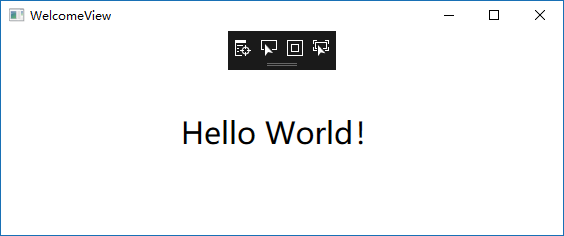MVVM Light 新手入门(2) :ViewModel / Model 中定义“属性” ,并在View中调用
今天学习MVVM架构中“属性”的添加并调用,特记录如下,学习资料均来自于网络,特别感谢翁智华的利刃 MVVMLight系列。
一个窗口的基本模型如下:
View(视图) -> ViewModel (视图模型)-> 多个Model(模型)
注:
- 视图是用户在屏幕上看到的结构、布局和外观(UI)
- 视图模型是暴露公共属性和命令的视图的抽象。在视图模型中,绑定器在视图和数据绑定器之间进行通信。
- 模型是指代表真实状态内容的领域模型(面向对象),或指代表内容的数据访问层(以数据为中心)。
下面开始学习最基础的写法
1、新建一个Model
public class WelcomeModel : ObservableObject { private String introduction; /// <summary> /// 欢迎词 /// </summary> public String Introduction { get { return introduction; } set { introduction = value; RaisePropertyChanged(() => Introduction); } } }
- 这个Model继承了一个父类:ObservableObject,这个父类的作用就是保证能够检测属性是否被改变。它实现了INotifyPropertyChanged接口,通过触发PropertyChanged事件达到通知UI更改的目的;
- 实体里面定义的每个属性都加上RaisePropertyChanged(PropertyName)的调用,就可以实现对UI的交互更新了。
public class WelcomeViewModel : ViewModelBase { /// <summary> /// 构造函数 /// </summary> public WelcomeViewModel() { Welcome = new WelcomeModel() { Introduction = "Hello World!" }; } #region 属性 private WelcomeModel welcome; /// <summary> /// 欢迎词属性 /// </summary> public WelcomeModel Welcome { get { return welcome; } set { welcome = value; RaisePropertyChanged(() => Welcome); } } #endregion }
<Window x:Class="Pvd.View.WelcomeView" xmlns="http://schemas.microsoft.com/winfx/2006/xaml/presentation" xmlns:d="http://schemas.microsoft.com/expression/blend/2008" xmlns:x="http://schemas.microsoft.com/winfx/2006/xaml" xmlns:mc="http://schemas.openxmlformats.org/markup-compatibility/2006" mc:Ignorable="d" Title="WelcomeView" Height="450" Width="800"> <Grid> <StackPanel VerticalAlignment="Center" HorizontalAlignment="Center" > <TextBlock Text="{Binding Welcome.Introduction}" FontSize="30" ></TextBlock> </StackPanel> </Grid> </Window>
TextBlock 绑定了 Welcome.Introduction,所以应该显示Welcome对象下的Introduction属性。
这时候的ViewModel和View是没有任何关系的,所以我们在code-Behind的构造函数中写上如下代码:
using Pvd.ViewModel; using System.Windows; namespace Pvd.View { /// <summary> /// WelcomeView.xaml 的交互逻辑 /// </summary> public partial class WelcomeView : Window { public WelcomeView() { InitializeComponent(); this.DataContext = new WelcomeViewModel(); } } }
把 WelcomeViewModel 赋值给当前视图的数据上下文。所以可以在当前视图中使用ViewModel中所有的公开属性和命令。
执行结果正常

总结:
1、通过 this.DataContext = new WelcomeViewModel(); 把 View 和 ViewModel 绑定。绑定后,可以直接在View中调用 ViewModel中公开的属性和命令
2、所有的VideModel 都需要继承于:ViewModelBase
3、所有的Model都继承于ObservableObject
4、定义属性方法如下,并在每个属性中都加上RaisePropertyChanged(PropertyName)的调用,就可以实现对UI的交互更新了。
private String ~introduction;
public String Introduction
{
get { return ~introduction; }
set { ~introduction= value; RaisePropertyChanged(() => Introduction); }
}
新手入门,理解上有偏差,请各位老师提宝贵意见。



 浙公网安备 33010602011771号
浙公网安备 33010602011771号